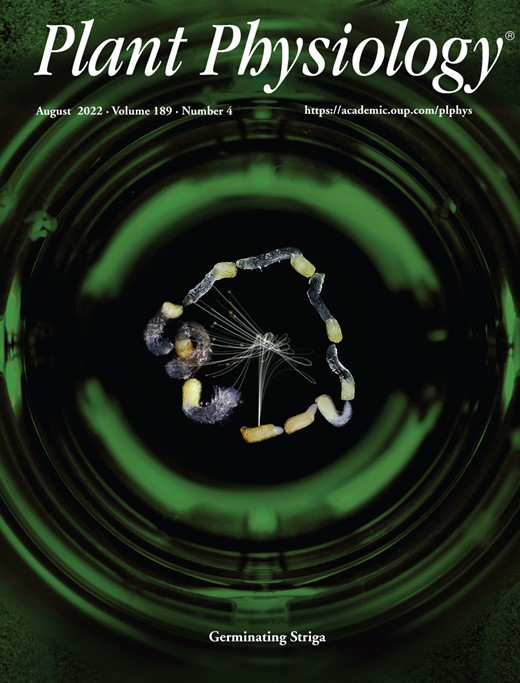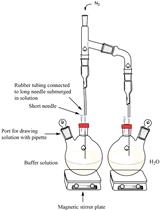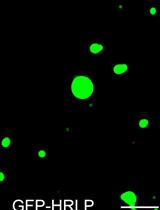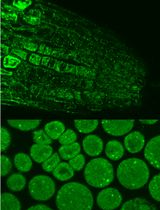- EN - English
- CN - 中文
A Semi-throughput Procedure for Assaying Plant NADP-malate Dehydrogenase Activity Using a Plate Reader
使用平板阅读器测定植物 NADP-苹果酸脱氢酶活性的半通量程序
发布: 2023年08月20日第13卷第16期 DOI: 10.21769/BioProtoc.4769 浏览次数: 1395
评审: Anonymous reviewer(s)
Abstract
Chloroplast NADP-dependent malate dehydrogenase (NADP-MDH) is a redox regulated enzyme playing an important role in plant redox homeostasis. Leaf NADP-MDH activation level is considered a proxy for the chloroplast redox status. NADP-MDH enzyme activity is commonly assayed spectrophotometrically by following oxaloacetate-dependent NADPH oxidation at 340 nm. We have developed a plate-adapted protocol to monitor NADP-MDH activity allowing faster data production and lower reagent consumption compared to the classic cuvette format of a spectrophotometer. We provide a detailed procedure to assay NADP-MDH activity and measure the enzyme activation state in purified protein preparations or in leaf extracts. This protocol is provided together with a semi-automatized data analysis procedure using an R script.
Keywords: NADP-malate dehydrogenase (NADP苹果酸脱氢酶)Background
Chloroplast NADP-dependent malate dehydrogenase (NADP-MDH) catalyzes the reduction of oxaloacetate to malate using NADPH. To be active, this enzyme needs to be reduced by thioredoxins (TRX), ubiquitous thiol-disulfide oxidoreductases (Issakidis et al., 1994; Collin et al., 2003). In C3 plants, NADP-MDH is involved in the export of reducing power from the chloroplast to the cytosol via the malate valve (Scheibe, 2004). TRX-dependent activation of NADP-MDH makes the link between the chloroplast electron transport chain, the redox state of the chloroplast, and the other cell compartments (Scheibe and Dietz, 2012; Heyno et al., 2014). Hence, the redox state of NADP-MDH is considered as a proxy for the plant leaf cellular redox state. NADP-MDH redox state in protein preparations or in plant extracts is deduced from the ratio between initial/extractable (i.e., activity of the enzyme or extract, without pre-treatment) and maximal activity/enzyme capacity (i.e., activity of the enzyme or in the extract, after reductive activation by TRX) (Issakidis et al., 1994; Keryer et al., 2004).
NADP-MDH activity can be easily assayed spectrophotometrically by monitoring oxaloacetate-dependent NADPH oxidation at 340 nm (Jacquot et al., 1995). Here, we developed a plate-adapted protocol to assay NADP-MDH activity of a large number of samples at the same time, associated with a semi-automatized data analysis procedure using a user-friendly R script. Compared with the classic method in a 1 mL spectrophotometer cuvette, the plate format allows increasing the experimental replicates and/or tested samples or conditions, for a gain of time (estimated divided by three), and in data precision and reliability, at a lower cost (divided by five). We implemented this method to measure NADP-MDH activity in Arabidopsis leaf protein extracts and using purified preparations of recombinant sorghum NADP-MDH. Our method is applicable to measure the activity of virtually any plant species.
Materials and reagents
General materials and reagents
Oxaloacetic acid (OAA) (Sigma-Aldrich, catalog number: O-4126)
β-Nicotinamide adenine dinucleotide 2’-phosphate reduced (NADPH) (Roth, catalog number: AE14.3)
Dithiothreitol (DTT) (Sigma-Aldrich, catalog number: D9779)
Tris pH 7.9
Classic PCR plate 96 wells (Thermo Fisher Scientific, catalog number: AB0700)
Plate 96 wells (Genetix X6011 96well)
Recombinant TRX m type (stored at -20 °C) (Collin et al., 2003)
Materials and reagents specific for in vitro assay
Recombinant NADP-MDH (stored at -20 °C) (Issakidis et al., 1994)
Materials and reagents specific for ex planta assay
4–5-week-old Arabidopsis plants
Metallic beads (3 mm diameter)
Protease inhibitor cocktail for plant (Sigma-Aldrich, catalog number: P9599)
Tris pH 6.8
QubitTM Protein and Protein Broad Range (BR) Assay kits (Thermo Fisher Scientific, catalog number: Q33212)
Solutions
Extraction buffer for ex planta assay (see Recipes)
Activation medium for ex planta assay (see Recipes)
Activation medium for the in vitro assay (see Recipes)
Reaction medium (see Recipes)
Equipment
Tecan infinite m200 PRO plate reader (Tecan) with a 230–1,000 nm wavelength range
Multichannel pipettes, 12 channels able to pipette 2–50 μL (Eppendorf)
General-purpose tweezers (Fisher Scientific, catalog number: 17-467-231)
Thermal cycler for incubation (Applied Biosystems 2720 Thermal Cycler)
Qubit 2.0 fluorometer (Thermo Fisher Scientific, Q32866) (for ex planta assay) (see Note 1)
Refrigerated microcentrifuge (Thermo Scientific, catalog number: 75-772-441)
Tissue Lyser II bead mill (Qiagen, catalog number: 85300)
Software
R (https://www.r-project.org/) version 3.6.3 or later
RStudio (https://www.rstudio.com/) version 2022.07.1+554 or later
Excel (Microsoft)
Notepad++ (https://notepad-plus-plus.org/) or any software to read text files
Magellan version 7.2 (https://lifesciences.tecan.com/software-magellan)
Procedure
文章信息
版权信息
© 2023 The Author(s); This is an open access article under the CC BY-NC license (https://creativecommons.org/licenses/by-nc/4.0/).
如何引用
Baudry, K. and Issakidis-Bourguet, E. (2023). A Semi-throughput Procedure for Assaying Plant NADP-malate Dehydrogenase Activity Using a Plate Reader. Bio-protocol 13(16): e4769. DOI: 10.21769/BioProtoc.4769.
分类
植物科学 > 植物生物化学 > 蛋白质 > 活性
生物化学 > 蛋白质 > 活性
您对这篇实验方法有问题吗?
在此处发布您的问题,我们将邀请本文作者来回答。同时,我们会将您的问题发布到Bio-protocol Exchange,以便寻求社区成员的帮助。
Share
Bluesky
X
Copy link













